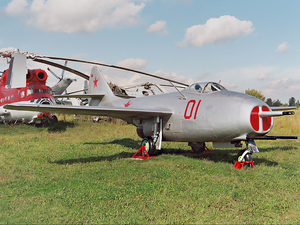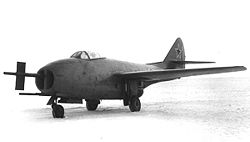Mikoyan-Gurevich MiG-9 Video - World War II video
|
|
Mikoyan-Gurevich MiG-9
MiG-9

Role: Fighter
Manufacturer: Mikoyan-Gurevich
First flight: 24 April 1946
Primary users: Soviet Air Force
PLA Air Force
Produced: 1946-1948
Number built: 598
The Mikoyan-Gurevich MiG-9 (Russian: ÐикоÑн и ÐÑÑÐµÐ²Ð¸Ñ ÐиÐ-9, USAF/DOD designation Type 1, NATO reporting name: Fargo) was a first-generation Soviet turbojet fighter and attack aircraft developed by Mikoyan-Gurevich in the years immediately after World War II.
Development
During a meeting at the Kremlin in February 1945, Stalin summoned the chief designers of all the fighter teams and complained about poor performance in the USSR's implementation of jet technology. He ordered that the first generation of Soviet jet fighters was to be equipped with German engines. MiG were instructed to use the BMW 003 engine, while the Yak team were instructed to use Jumo engines. Because the BMW engines were smaller than the Lyulkas originally intended for the MiG-9, the fighter's airframe had to be reduced in diameter. The MiG and Sukhoi teams were also instructed that their aircraft had to incorporate a 37mm Nudelman NS-37 cannon.
The first test aircraft, the I-300 (also called the izdeliye F {model F or product F} by OKB) prototype, arrived at the Chkalovskaya proving ground in spring 1946 where the Yak-15 prototype was already waiting. A coin was tossed to determine which team was to have the honour of the first Soviet test flight and the MiG won, and was first flown on 24 April 1946 by test pilot Alexei N. "Lesha" Grinchik.
The I-300 was an all-metal design, with simple straight wings with slotted flaps and delta shaped tail surfaces. It was also one of the first Soviet designed fighters featuring tricycle landing gear. Its powerplant comprised two RD-20 turbojets, which were Soviet-manufactured versions of the captured German BMW 003. In some instances, due to shortages and failed delivery of the RD-20 engines, actual BMW 003 engines were used in some production aircraft.
The twin engines were located behind the cockpit in the lower fuselage, with the exhaust exiting under the tail unit. This design was frequently used by the Soviet OKBs in early jet designs. Several issues arose attempting to protect the tail unit from the hot exhaust gasses, which eventually led to a steel laminate heatshield being installed along most of the bottom of the tail. There were four bag-type fuel tanks in the fuselage and three in each wing, providing a total internal fuel capacity of 1,625 liters (429 US gallons).
While the planned armament was based on the NL-57 57mm cannon mounted in the centerline engine intake bulkhead, the production versions of the MiG-9 were commonly armed with a single 37 mm and two 23 mm NS-23 cannons. The mounting of the three cannons was unusual with the NL-37 being mounted in the centerline engine intake bulkhead, and the two smaller cannon firing out the lower lip of the intake. This unusual location of heavy cannon is suspected to have caused several pilot deaths due to gun gas ingestion and led to restrictions on heavy cannon use at various altitudes.
Unusually, the I-300 did not feature an ejection seat.
Service
The I-300 reached a speed of 910 km/h (565 mph) during initial tests, and after further refinement, it entered service with the VVS as the MiG-9 during the winter of 1946-47. The jet had many performance- and steering-related problems, however it was put into service mainly because of political considerations. These led directly to the death of Alexei N. Grinchik on 11 July 1946 when he crashed a prototype I-300 while flying demonstration flights for the VVS leadership and government officials.

Picture - MiG-9 "The Butterfly"
The final production MiG-9 was allocated the NATO reporting name of "Fargo" and the Soviet designation I-301. Later designs of the MiG-9 attempted to resolve many of the issues encountered in the I-300, including the fit of a rectangular fin to the 37 millimeter cannon barrel, giving the configuration the nickname "The Butterfly", however none of them worked very well. In the end, the entire nose was redesigned with the cannon barrel muzzles moved behind the engine intake and with the cockpit moved forward. The result was the single "MiG-9M", which also featured an ejection seat and RD-21 engines, the RD-21 being an afterburning variant of the RD-20 / BMW-003.
The MiG-9 was deployed largely in the ground-attack role and 610 aircraft were built in different versions by the time production ended in 1948.
Versions
I-300 : Prototype.
MiG-9 (F) : "aircraft F" - the only serial variant, RD-20 engines
MiG-9 (FP) : "aircraft FP", I-302 - prototype with modified weapons layout
MiG-9 (FL) : "aircraft FL", I-305 - variant with Lyulka TR-1A engines, not completed
MiG-9 (FF) : "aircraft FF", I-307 - prototypes with afterburned RD-20F or RD-21 engines
MiG-9L: Prototype aircraft to test the avionics for the Raduga KS-1 Komet air-launched antishipping cruise missile
MiG-9M (FR) : "aircraft FR", I-308 - modified prototypes with RD-21 engines
MIG-9UTI : Two-seat training aircraft. Around 80 built. Also known as the I-301T.
Operators
Soviet Union
Soviet Air Force
People's Republic of China
People's Liberation Army Air Force
Specifications (MiG-9)
Data from The Great Book of Fighters
General characteristics
Crew: One
Length: 9.83 m (32 ft 3 in)
Wingspan: 10 m (32 ft 10 in)
Height: 3.22 m (10 ft 7 in)
Wing area: 18.20 m² (195.9 ft²)
Empty weight: 3,420 kg (7,540 lb)
Loaded weight: 4,965 kg (10,945 lb)
Max takeoff weight: 5,500 kg (12,125 lb)
Powerplant: 2x Kolesov RD-20 turbojets , 7.8 kN (1754 lbf) each
Performance
Maximum speed: Mach 0.8, 910 km/h (565 mph) at 4,500 m (14,765 ft)
Range: 800 km (495 mi)
Service ceiling: 13,000 m (42,650 ft)
Rate of climb: 19.4 m/s (3,815 ft/min)
Thrust/weight: 0.40
Armament
1 x 37 mm NL-37 cannon
2 x 23 mm NS-23 cannons
Comparable aircraft
Dassault Ouragan
de Havilland Vampire
P-80 Shooting Star
SAAB J29
Living Warbirds: The best warbirds DVD series.
Source: WikiPedia